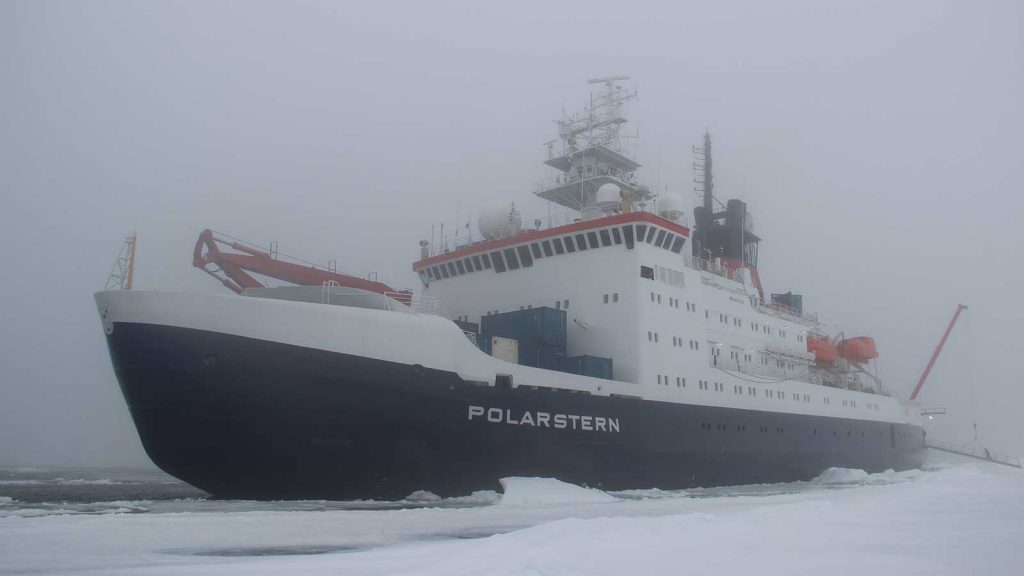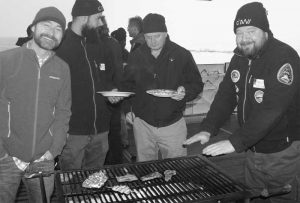
(Photo by Chris German, ©Woods Hole Oceanographic Institution)
The rest of Wednesday passed quietly and ended well with a barbecue on deck. That’s right, all kinds of exotic meats being grilled over charcoal as we steamed past ice floes. I guess summer isn’t over until we SAY it is over! But it wasn’t exactly T-shirt weather.
We changed the ship’s clocks for the second and final time overnight and now we are on the same time zone as Muscat, Oman—the location of one of my first expeditions as a graduate student in 1986—as well as Mauritius in the Indian Ocean, which was the site of the longest expedition of my career (70 days at sea, with only 5 days ashore in the middle) in 2001. Needless to say, this is not the warmest place I have visited.

Kevin, Bermann, Louis and Boris keeping warm around the grill–and yes, those really are ice floes over Louis’ shoulder. (photo by Chris German, Woods Hole Oceanographic Institution)
Happily, for this, my second trip to the Arctic, I have come prepared. When we first took NUI to sea in 2014, I discovered that the jacket I had bought in 2000 for cold weather in the U.K. was far inferior to the full body suits the engineers had. It was hard to blame the person in charge of cruise planning, since that was me.
But as I explained in my “Methods of Vent Exploration” lecture on the ship a few nights ago, it is always more interesting to make new mistakes in life than to repeat old ones. So this year I am the proud owner of a shiny new Mustang suit—a bright orange-and-black jump suit that is thermally insulated and will even float if the gang get fed up with me and force me to walk the plank. Best of all, today I got to use it. Last night, we arrived at our first major work area where today we have been doing some sampling to make sure we know everything about “normal” sediments, seawater, and ice in the Arctic Ocean well away from the influence of any hydrothermal vents far below.
Our colleagues from AWI (Alfred Wegener Institute for Marine and Polar Research in Bremerhaven, Germany) also conducted some very impressive “key hole” work recovering instruments on a mile-long cable through a hole in the ice that was just a few meters across. They used the ship to smash a much larger hole in the ice when the top instrument appeared, but it was impressive was to watch the choreography as all the sampling and measuring devices came out of the water and on deck, one after another, after being moored to the seafloor for over a year. The instruments have been monitoring ocean conditions in this part of the Arctic since then, including all through the winter, which is NOT a good time to get on a ship and come here to measure things directly!
But I digress. As soon as the mooring recovery was complete, it was time for our first ice station of the cruise. First, we moved the ship up alongside a good, solid-looking ice floe several times the size of the ship. Then the gangplank went down and Marcel and Christian stepped “ashore” to check the integrity of the ice, its depth, and to scout out locations for their research. Next on the ice were two snowmobiles, some sleds for transporting equipment, and, finally, a 10’X10′ container lab. These people mean business! Within little more than an hour, a new base camp was established about 200 meters away from the ice edge and I watched wistfully as Kevin and Andrew from our team headed out to collect the first ice cores for their part of our project.
Then the news came through from the bridge: All scientists interested in walking out on the ice should attend a mandatory safety briefing from the captain. The briefing was short and to the point but ended, to put us at our ease, with two final warnings: Don’t eat any yellow snow and, if you have to run for safety (presumably from polar bears), run faster than your buddy. Within the hour we were all suited, booted, and walking on frozen water 4000 meters above the seafloor!
The ice was solid underfoot, but with a good inch or so of broken up snow/ice mix that gave our boots a good grip. And really flat. Wow. I’ve done this once before, but quickly remembered (a) what a cool thing it is to do and (b) how quickly it feels normal to be walking around on snow and ice looking up at a massive ship parked up along us in the middle of that vast, flat expanse. I just try not to think about the other expanse just 3-6 feet beneath the ice.
All too soon, a bank of fog started rolling in and the call came out from the ship that we all needed to move back on board. The ice team got to head out again later when the weather cleared, but Kevin and Andrew are now back on ship with the first set of samples for our project in the bank.
Tomorrow we get back on the road so to speak and should be at the ridge-axis the day after. Then the REAL fun (for me) begins. Re-mapping the Karasik Seamount before the ocean freezes over, then a first camera tow over the summit, water sampling and sensing to look for signs of hydrothermal activity, and a first dunk-test for NUI are the first things on our agenda once we get there, so it is time to take a look at our check list:
- Laundry: Freshly done, with enough clean clothes for at least a week? Done.
- Champagne purchased and chilling ready for any discoveries we make before the ship’s store reopens next Monday? Done (It is ALWAYS good to plan ahead!)
That’s the complete list, I think. We’re ready to head for the seafloor! Let’s hope it is still down there. 🙂

